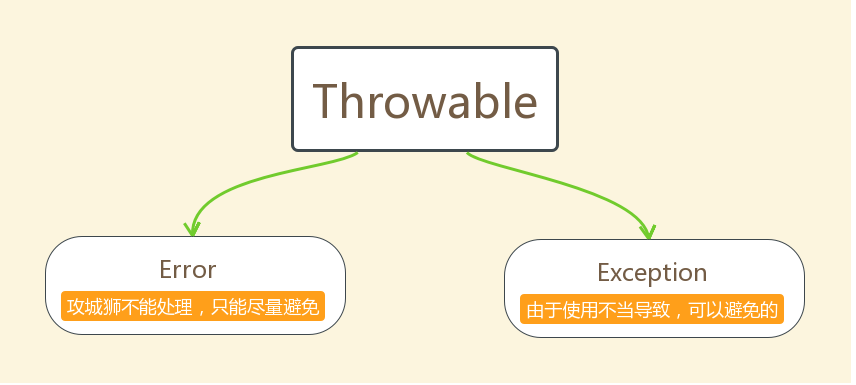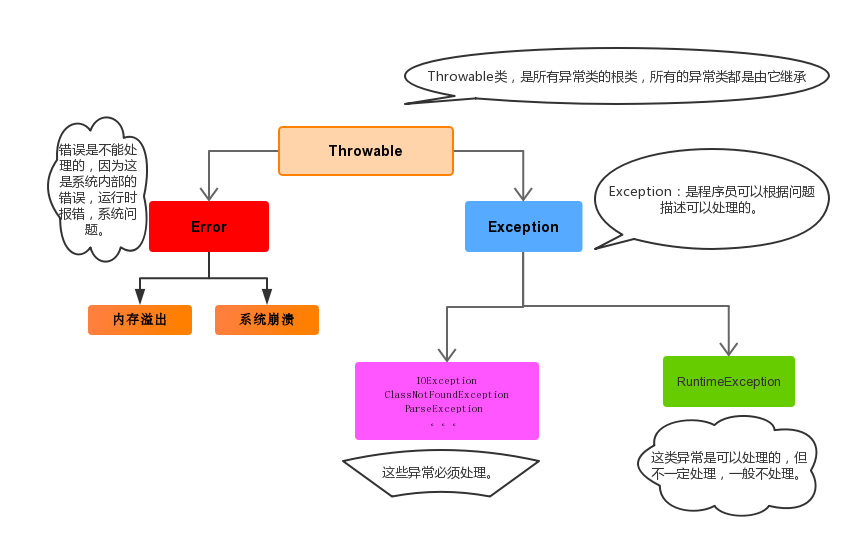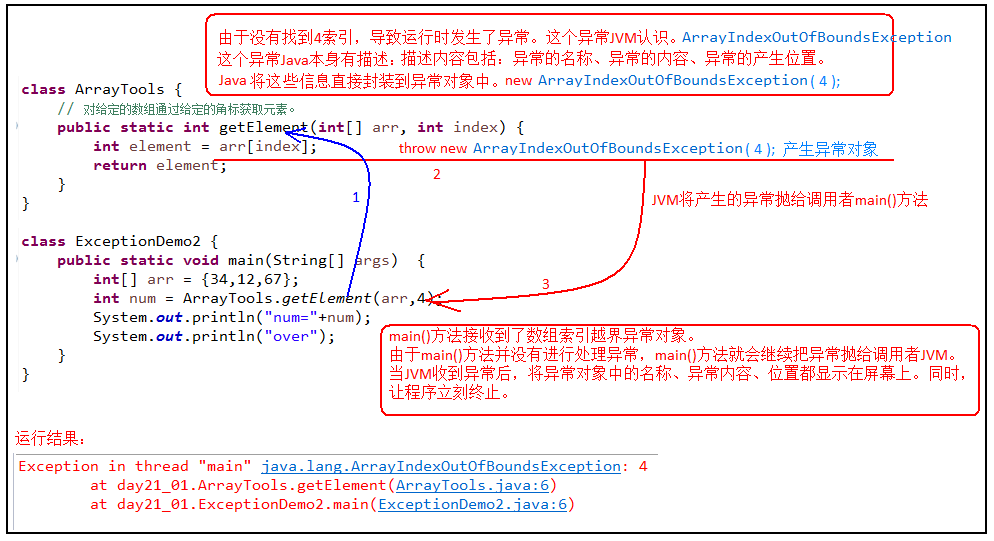异常 异常 异常概念 异常,就是不正常的意思。在生活中:医生说,你的身体某个部位有异常,该部位和正常相比有点不同,该部位的功能将受影响.在程序中的意思就是:
异常 :指的是程序在执行过程中,出现的非正常的情况,最终会导致JVM的非正常停止。
注意: 在Java等面向对象的编程语言中,异常本身是一个类,产生异常就是创建异常对象并抛出了一个异常对象 。Java处理异常的方式是中断处理。
异常指的并不是语法错误,语法错了,编译不通过,不会产生字节码文件,根本不能运行.
异常体系 异常机制其实是帮助我们找到 程序中的问题,异常的根类是java.lang.Throwable,其下有两个子类:java.lang.Error与java.lang.Exception,平常所说的异常指java.lang.Exception。
Throwable体系:
Error :严重错误Error,无法通过处理的错误,只能事先避免,好比绝症。Exception :表示异常,异常产生后程序员可以通过代码的方式纠正,使程序继续运行,是必须要处理的。好比感冒、阑尾炎。
异常分类 我们平常说的异常就是指Exception,因为这类异常一旦出现,我们就要对代码进行更正,修复程序。
异常(Exception)的分类 :根据在编译时期还是运行时期去检查异常?
编译时期异常 :checked异常。在编译时期,就会检查,如果没有处理异常,则编译失败。(如日期格式化异常)运行时期异常 :runtime异常。在运行时期,检查异常.在编译时期,运行异常不会编译器检测(不报错)。(如数学异常)
异常的产生过程解析 先运行下面的程序,程序会产生一个数组索引越界异常ArrayIndexOfBoundsException。我们通过图解来解析下异常产生的过程。
工具类
1 2 3 4 5 6 7 public class ArrayTools { public static int getElement (int [] arr, int index) { int element = arr[index]; return element; } }
测试类
1 2 3 4 5 6 7 8 public class ExceptionDemo { public static void main (String[] args) { int [] arr = { 34 , 12 , 67 }; intnum = ArrayTools.getElement(arr, 4 ) System.out.println("num=" + num); System.out.println("over" ); } }
上述程序执行过程图解:
异常的产生和处理 异常的产生 throw关键字的作用 在java中,提供了一个throw 关键字,它用来抛出一个指定的异常对象。throw用在方法内 ,用来抛出一个异常对象,将这个异常对象传递到调用者处,并结束当前方法的执行。
throw关键字的使用格式 例如:
1 2 throw new NullPointerException ("要访问的arr数组不存在" );throw new ArrayIndexOutOfBoundsException ("该索引在数组中不存在,已超出范围" );
案例演示 1 2 3 4 5 6 7 8 9 10 11 12 13 14 15 16 17 18 19 20 21 22 23 24 25 26 27 28 / public class Test { public static void main (String[] args) { int [] arr = {10 ,20 ,30 ,40 }; method(arr,4 ); } public static void method (int [] arr,int index) { if (index < 0 || index > arr.length-1 ){ throw new ArrayIndexOutOfBoundsException (index+"" ); }else { int num = arr[index]; System.out.println(num); } } }
声明处理异常 声明处理异常的概述 声明处理异常 :使用throws关键字将问题标识出来, 表示当前方法不处理异常,而是提醒给调用者, 让调用者来处理….最终会到虚拟机,虚拟机直接结束程序,打印异常信息。
声明处理异常格式 1 2 修饰符 返回值类型 方法名(参数) throws 异常类名1 ,异常类名2 …{ }
案例演示 1 2 3 4 5 6 7 8 9 10 11 12 13 14 15 16 17 18 19 20 21 22 23 24 25 26 27 28 29 30 31 32 33 34 35 36 37 38 39 40 41 42 43 44 45 46 47 48 49 50 51 52 53 public class Test { public static void main (String[] args) throws ParseException { SimpleDateFormat sdf = new SimpleDateFormat ("yyyy-MM-dd" ); Date date = sdf.parse("1999-10-10" ); System.out.println(date); System.out.println("结束" ); } public static void method1 () throws ParseException{ throw new ParseException ("解析异常" ,1 ); } public static void method2 (int num) throws ParseException,FileNotFoundException{ if (num == 1 ){ throw new ParseException ("解析异常" ,1 ); }else { throw new FileNotFoundException ("文件找不到异常" ); } } }
捕获处理异常try…catch 捕获处理异常的概述
捕获处理异常 :对异常进行捕获处理 , 处理完后程序可以正常向下执行。
捕获处理异常格式 1 2 3 4 5 6 7 8 9 try { 编写可能会出现异常的代码 }catch (异常类型 e){ 处理异常的代码 } 执行步骤: 1. 首先执行try 中的代码,如果try 中的代码出现了异常,那么就直接执行catch ()里面的代码,执行完后,程序继续往下执行 2. 如果try 中的代码没有出现异常,那么就不会执行catch ()里面的代码,而是继续往下执行
注意:
try和catch都不能单独使用,必须连用。
try中的代码出现了异常,那么出现异常位置后面的代码就不会再执行了
捕获处理异常,如果程序出现了异常,程序会继续往下执行
声明处理异常,如果程序出现了异常,程序就不会继续往下执行
演示如下:
1 2 3 4 5 6 7 8 9 10 11 12 13 14 15 16 17 18 19 20 21 22 23 24 25 26 27 28 29 30 31 32 33 34 35 36 37 38 39 40 41 42 43 44 45 46 public class Test { public static void main (String[] args) { method1(); System.out.println("======================" ); try { System.out.println(1 /1 ); }catch (ArithmeticException e){ System.out.println("出现了数学运算异常" ); } System.out.println("======================" ); try { System.out.println(1 /0 ); System.out.println("try..." ); }catch (ArithmeticException e){ System.out.println("出现了数学运算异常" ); } System.out.println("结束" ); } public static void method1 () { try { throw new ParseException ("解析异常" ,1 ); }catch (ParseException e){ System.out.println("出现了异常" ); } System.out.println("method1方法结束..." ); } }
获取异常信息 Throwable类中定义了一些查看方法:
public String getMessage():获取异常的描述信息,原因(提示给用户的时候,就提示错误原因。
public String toString():获取异常的类型和异常描述信息(不用)。
public void printStackTrace():打印异常的跟踪栈信息并输出到控制台。
包含了异常的类型,异常的原因,还包括异常出现的位置,在开发和调试阶段,都得使用printStackTrace。
在开发中呢也可以在catch将编译期异常转换成运行期异常处理。
1 2 3 4 5 6 7 8 9 10 11 12 13 14 15 16 17 18 19 20 21 22 23 24 25 26 public class Test { public static void main (String[] args) { System.out.println("开始" ); try { System.out.println(1 /0 ); }catch (ArithmeticException e){ e.printStackTrace(); } System.out.println("结束" ); } }
finally 代码块 finally代码块的概述 finally :有一些特定的代码无论异常是否发生,都需要执行。另外,因为异常会引发程序跳转,导致有些语句执行不到。而finally就是解决这个问题的,在finally代码块中存放的代码都是一定会被执行的。
finally代码块的语法格式 1 2 3 4 5 6 7 8 9 10 11 12 try { 可能会出现异常的代码 }catch (异常的类型 变量名){ 处理异常的代码或者打印异常的信息 }finally { 无论异常是否发生,都会执行这里的代码(正常情况,都会执行finally 中的代码,一般用来释放资源) } 执行步骤: 1. 首先执行try 中的代码,如果try 中的代码出现了异常,那么就直接执行catch ()里面的代码,执行完后会执行finally 中的代码,然后程序继续往下执行 2. 如果try 中的代码没有出现异常,那么就不会执行catch ()里面的代码,但是还是会执行finally 中的代码,然后程序继续往下执行
注意:finally不能单独使用。
案例演示 1 2 3 4 5 6 7 8 9 10 11 12 13 14 15 16 17 18 19 20 21 22 23 24 25 26 27 28 29 30 31 32 33 34 35 36 37 38 39 40 41 42 43 public class Test { public static void main (String[] args) { System.out.println("开始" ); System.out.println("================================" ); try { System.out.println(1 /1 ); return ; }catch (ArithmeticException e){ System.out.println("catch 出现了异常" ); }finally { System.out.println("finally 无论是否发生异常都会执行" ); } System.out.println("结束" ); } }
当只有在try或者catch中调用退出JVM的相关方法,此时finally才不会执行,否则finally永远会执行。
finally经典面试题 1 2 3 4 5 6 7 8 9 10 11 12 13 14 15 16 17 18 19 20 21 22 23 24 25 26 27 28 29 30 31 32 33 34 public class Test { public static void main (String[] args) { System.out.println(method1()); System.out.println(method2()); } public static int method1 () { int num = 10 ; try { System.out.println(1 / 0 ); } catch (ArithmeticException e) { num = 20 ; return num; } finally { num = 30 ; return num; } } public static int method2 () { int num = 10 ; try { System.out.println(1 / 0 ); } catch (ArithmeticException e) { num = 20 ; return num; } finally { num = 30 ; } return num; } }
异常注意事项
运行时异常被抛出可以不处理。即不捕获也不声明抛出。
如果父类的方法抛出了多个异常,子类覆盖(重写)父类方法时,只能抛出相同的异常或者是他的子集。
父类方法没有抛出异常,子类覆盖父类该方法时也不可抛出异常。此时子类产生该异常,只能捕获处理,不能声明抛出
声明处理多个异常,可以直接声明这多个异常的父类异常
在try/catch后可以追加finally代码块,其中的代码一定会被执行,通常用于资源回收。
多个异常使用捕获又该如何处理呢?
多个异常分别处理。
多个异常一次捕获,多次处理。
多个异常一次捕获一次处理。
当多异常分别处理时,捕获处理,前边的类不能是后边类的父类
一般我们是使用一次捕获多次处理方式,格式如下:
1 2 3 4 5 6 7 8 9 try { 编写可能会出现异常的代码 }catch (异常类型A e){ 当try 中出现A类型异常,就用该catch 来捕获. 处理异常的代码 }catch (异常类型B e){ 当try 中出现B类型异常,就用该catch 来捕获. 处理异常的代码 }
注意:这种异常处理方式,要求多个catch中的异常不能相同,并且若catch中的多个异常之间有子父类异常的关系,那么子类异常要求在上面的catch处理,父类异常在下面的catch处理。
代码如下:
1 2 3 4 5 6 7 8 9 10 11 12 13 14 15 16 17 18 19 20 21 22 23 24 25 26 27 28 29 30 31 32 33 34 35 36 37 38 39 40 41 42 43 44 45 46 47 48 49 50 51 52 53 54 55 56 57 58 59 60 61 62 63 64 65 66 67 68 69 70 71 72 73 74 75 76 77 78 79 80 81 82 83 84 85 86 87 88 89 90 91 92 93 94 95 96 97 98 99 100 101 102 103 104 105 106 107 108 109 110 111 112 113 114 115 116 117 118 class Fu { public void show () throws ParseException, FileNotFoundException { } public void run () { } } class Zi extends Fu { @Override public void run () { try { throw new FileNotFoundException ("" ); }catch (FileNotFoundException e){ } } } public class Test { public static void main (String[] args) { } public static void show1 () { System.out.println(1 / 0 ); } public static void show2 (int num) throws Exception{ if (num == 1 ){ throw new FileNotFoundException ("" ); }else { throw new ParseException ("" ,1 ); } } public static void show3 (int num) { if (num == 1 ){ try { throw new FileNotFoundException ("" ); } catch (FileNotFoundException e) { } }else { try { throw new ParseException ("" ,1 ); } catch (ParseException e) { } } } public static void show4 (int num) { try { if (num == 1 ){ throw new FileNotFoundException ("" ); }else { throw new ParseException ("" ,1 ); } }catch (FileNotFoundException e){ }catch (ParseException e){ } } public static void show5 (int num) { try { if (num == 1 ){ throw new FileNotFoundException ("" ); }else { throw new ParseException ("" ,1 ); } }catch (Exception e){ } } public static void show6 (int num) { try { if (num == 1 ){ throw new FileNotFoundException ("" ); }else { throw new ParseException ("" ,1 ); } }catch (Exception e){ } } }
自定义异常 自定义异常概述 为什么需要自定义异常类:
我们说了Java中不同的异常类,分别表示着某一种具体的异常情况,那么在开发中总是有些异常情况是SUN没有定义好的,例如年龄负数问题,考试成绩负数问题.这些异常在JDK中没有定义过,此时我们根据自己业务的异常情况来定义异常类。
什么是自定义异常类:
在开发中根据自己业务的异常情况来定义异常类.
自定义一个业务逻辑异常: RegisterException 。一个注册异常类。
异常类如何定义:
自定义一个编译期异常: 自定义类 并继承于java.lang.Exception。
自定义一个运行时期的异常类:自定义类 并继承于java.lang.RuntimeException。
1 2 3 4 5 6 7 8 9 10 11 12 13 14 15 16 17 18 19 20 21 22 23 24 25 26 27 28 29 30 31 32 33 34 35 36 37 public class MyException1 extends Exception { public MyException1 () { } public MyException1 (String message) { super (message); } } public class MyException2 extends RuntimeException { public MyException2 () { } public MyException2 (String message) { super (message); } } public class Test { public static void main (String[] args) { throw new MyException2 ("自定义异常2" ); } }
自定义异常的练习 要求:我们模拟注册操作,如果用户名已存在,则抛出异常并提示:亲,该用户名已经被注册。
首先定义一个注册异常类RegisterException:
1 2 3 4 5 6 7 8 9 10 11 12 13 14 15 16 public class RegisterException extends Exception { public RegisterException () { } public RegisterException (String message) { super (message); } }
模拟登陆操作,使用数组模拟数据库中存储的数据,并提供当前注册账号是否存在方法用于判断。
1 2 3 4 5 6 7 8 9 10 11 12 13 14 15 16 17 18 19 20 21 22 23 24 25 26 27 28 29 30 public class Test { public static void main (String[] args) { String[] names = {"jack" , "rose" , "jim" , "tom" }; Scanner sc = new Scanner (System.in); System.out.println("请输入一个用户名:" ); String name = sc.next(); for (String s : names) { if (s.equals(name)) { try { throw new RegisterException ("亲,该用户名已经被注册。" ); } catch (RegisterException e) { System.out.println(e.getMessage()); return ; } } } System.out.println("亲,恭喜您注册成功!" ); } }







